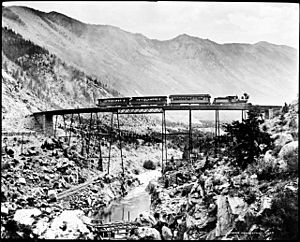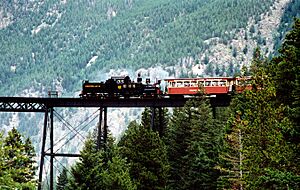Georgetown Loop Railroad facts for kids
Quick facts for kids Georgetown Loop Railroad |
|
|---|---|

Train on the Georgetown Loop Railroad, about 1885.
|
|
| Locale | Georgetown, Colorado |
| Terminus | Silver Plume, Colorado |
| Commercial operations | |
| Original gauge | 3 ft (914 mm) |
| Preserved operations | |
| Owned by | Colorado Historical Society |
| Operated by | Historic Rail Adventures, LLC |
| Reporting mark | GLRX |
| Length | 4.5 mi (7.2 km) |
| Preserved gauge | 3 ft (914 mm) |
| Commercial history | |
| Opened | 1877 |
| Closed | 1938 |
| Preservation history | |
| 1984 | Reopened |
|
Georgetown Loop Railroad
|
|
| Lua error in Module:Location_map at line 420: attempt to index field 'wikibase' (a nil value). | |
| Nearest city | Silver Plume, Colorado |
| Built | 1877 |
| NRHP reference No. | 70000909 |
| Added to NRHP | December 18, 1970 |
| {{{events1}}} | |

The Georgetown Loop Railroad is a special kind of train line in the Rocky Mountains of Colorado. It's called a 'narrow gauge' railway because its tracks are closer together than regular train tracks. It's also a 'heritage railroad,' meaning it's kept working to show people what trains were like a long time ago.
This fun tourist train travels between two towns, Georgetown and Silver Plume. Even though the towns are only about 2 miles (3.2 km) apart, the train takes a longer, winding path of 4.5 miles (7.2 km). Along the way, it climbs about 640 feet (195 m) through mountains, crossing bridges and going through cuts in the land.
The railroad is located close to a big highway called I-70. You can find the Silver Plume train station right next to the highway's on-ramp. There's also a special parking area called Georgetown Loop Overlook on I-70 where you can stop and enjoy amazing views of the train line. A trail called the Clear Creek Greenway Trail connects the Silver Plume station, the overlook, and the Devil's Gate Station near Georgetown. This trail is great for biking and hiking.
Contents
The Railroad's Story
The Georgetown Loop Railroad was one of the very first places people visited for fun in Colorado. This amazing narrow gauge railroad was finished in 1884. People at the time thought it was an incredible feat of engineering.
Building a Mountain Marvel
The towns of Georgetown and Silver Plume were busy mining towns. They were only about 2 miles (3.2 km) apart in a deep, narrow canyon in the Rocky Mountains. But the engineers who built the train line couldn't just go straight. They had to design a twisting, corkscrew-like route that was almost twice as long.
This clever design allowed the train to slowly climb more than 600 feet (183 m) in height. The route included sharp curves, steep slopes, and four bridges that crossed Clear Creek. One of the most impressive parts was the huge Devil's Gate High Bridge.
The company that built the Loop section was called the Georgetown, Breckenridge, and Leadville Railroad. It was part of a larger train system owned by the Union Pacific Railroad. The Loop was the most exciting part of the line, crossing high above the gorge on a 95-foot (29 m) tall wooden bridge.
A Busy Mining Route
The Georgetown Loop was originally part of the Colorado Central Railroad, built in the 1870s and 1880s. It was used a lot during the Colorado Gold Rush and later during the Colorado Silver Boom in the 1880s. Trains carried valuable silver ore from the mines in Silver Plume.
Later, in 1893, another company called the Colorado and Southern Railway took over the line. They used it to carry both people and goods until 1938. For a while, from 1906 to 1918, the Georgetown Loop even connected with another railway called the Argentine Central Railway in Silver Plume. This allowed tourists to travel even higher up to the top of Mount McClellan.
The original train line was taken apart in 1939. However, it was rebuilt in the 1980s. Now, it runs during the summer months as a tourist train, carrying passengers using old-fashioned steam locomotives.
Bringing the Loop Back to Life
In 1959, which was 100 years after gold was found in Georgetown, a group called the Georgetown Loop Historic Mining & Railroad Park was created by the Colorado Historical Society. They worked to get donations of old mining areas and land to help restore the railroad.
Rebuilding the Tracks
In the 1970s, people became very interested in bringing the Loop back as a tourist attraction. So, in 1973, they started building new tracks along the old path. The Union Pacific Railroad even donated tracks and wooden ties. A new high bridge was also built, looking just like the original one.
Because modern buildings blocked the way to the old train station in downtown Georgetown, the new track ended just below the Loop at a place called Devil's Gate. This spot is about three-quarters of a mile (1.2 km) southwest of the city.
The restored section of the railroad, which is about 3 miles (4.8 km) long, opened on March 10, 1984. The Georgetown Loop Railroad climbs about 640 feet (195 m) between the two towns using these 3 miles of track. Passengers can get on the train at stations in Silver Plume and Devil's Gate.
Exploring the Lebanon Silver Mine
The train ride also offers an exciting extra activity: a walking tour of the Lebanon Silver Mine. This mine is located halfway along the railroad. Visitors can walk 500 feet (150 m) into a mine tunnel that was dug in the 1870s. Guides point out where rich silver veins used to be and share stories about the mine's history.
Challenges and Comeback
The Loop ran smoothly for 30 years after it was rebuilt. But in 2004, there were problems with the company that was running the train. This led to a new company taking over.
Tough Times for the Railroad
After the new company, Railstar, took over, the Loop faced some difficulties. There weren't enough steam locomotives, and sometimes trains would go off the tracks, which led to investigations. The equipment also broke down often, causing the railroad to close for days during busy tourist times. At its lowest point, the number of people riding the Loop each year dropped a lot, which made local businesses and train fans unhappy.
One example of the problems happened in 2006. An old steam locomotive, #9, was fixed up to run on the Loop. But the company made it pull trains that were too long and heavy for it. This badly damaged the locomotive, and it couldn't run anymore after less than one summer season. It had to be put back on display instead.
A New Beginning
In 2009, the Colorado Historical Society decided to end their contract with Railstar. They chose a new company, run by a local businessman from Georgetown, to operate the railroad. This new company, called Historic Rail Adventures LLC, still runs the Georgetown Loop today.
Since then, things have gotten much better for the railroad. Three steam engines are now working again, and the trains are more reliable. More people are riding the Georgetown Loop Railroad, enjoying its history and the beautiful mountain views.
See also
- National Register of Historic Places listings in Clear Creek County, Colorado
- List of Colorado historic railroads
- List of heritage railroads in the United States

